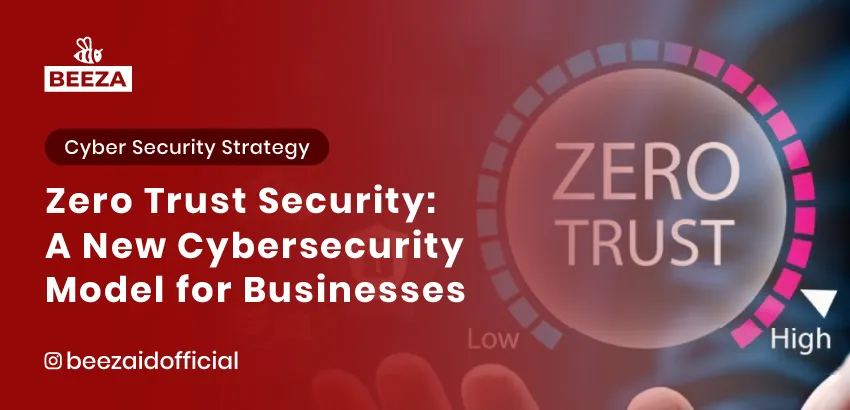
Introduction: Understanding Zero Trust Security
With the growing number of cyber threats, traditional security models that rely on perimeter-based protection are no longer sufficient. Cyberattacks have become more sophisticated and can come from both external and internal sources.
This is where Zero Trust Security comes into play. Unlike traditional security models that automatically trust users within a network, Zero Trust assumes that no one should be trusted by default, whether they are inside or outside the organization.
This article explores the concept of Zero Trust Security, its key principles, benefits for businesses, and how organizations can implement it effectively.
What is Zero Trust Security?
Zero Trust Security is a cybersecurity framework that requires all users, devices, and applications to be verified before they can access a company’s data or systems. Instead of assuming that everything inside a corporate network is safe, Zero Trust follows the principle of “Never Trust, Always Verify.”
The core principles of Zero Trust Security include:
✅ Strict Authentication – All access requires multi-factor authentication (MFA).
✅ Least Privilege Access – Users only get the minimum access they need.
✅ Network Segmentation – Access is limited to specific areas of the system.
✅ Continuous Monitoring – Suspicious activities are analyzed in real-time.
Why Businesses Need Zero Trust Security
In today’s digital landscape, businesses face various security threats, including ransomware, phishing attacks, insider threats, and data breaches. As more companies shift to cloud-based services and remote work environments, traditional security methods become ineffective.
Here’s why Zero Trust is the right solution:
1. Prevents Data Breaches
Zero Trust significantly reduces the risk of unauthorized access by ensuring that only verified users can access sensitive company data. This prevents data leaks and cyberattacks from both external and internal threats.
2. Mitigates Insider Threats
Many cybersecurity breaches occur due to insider threats, whether intentional or accidental. With strict access control and network segmentation, Zero Trust limits insider threats by restricting unnecessary access to critical systems.
3. Supports Hybrid and Remote Work Security
As remote work continues to grow, companies can no longer rely on office-based security measures. Zero Trust ensures secure access to business systems from any location, without depending on outdated firewall protections.
4. Enhances Compliance with Security Regulations
Regulations like GDPR, ISO 27001, and NIST cybersecurity frameworks require companies to enforce strict security measures. Zero Trust helps businesses stay compliant by enforcing continuous verification and access restrictions.
5. Reduces Cybersecurity Risks and Improves Incident Response
Since Zero Trust continuously monitors user activities, it can detect and respond to potential threats before they cause serious damage. This proactive security approach helps businesses minimize risks and prevent costly cyber incidents.
How to Implement Zero Trust Security in Your Business
1. Identify and Classify Critical Business Data
The first step in implementing Zero Trust is to identify sensitive business data and prioritize which systems require the highest level of protection. This includes customer information, financial records, and confidential business data.
2. Enforce Multi-Factor Authentication (MFA)
Multi-Factor Authentication (MFA) ensures that users must verify their identity using multiple authentication methods before accessing systems. This prevents cybercriminals from gaining access even if passwords are compromised.
3. Apply the Least Privilege Access Principle
Users should only be granted the minimum level of access they need to perform their job. This limits the risk of unauthorized access and prevents privilege misuse.
4. Segment Networks to Limit Access
Instead of giving users full access to the entire network, Zero Trust segments networks into isolated zones. If an attacker breaches one section, they cannot move laterally across the system.
5. Use AI-Based Threat Detection and Monitoring
Zero Trust relies on artificial intelligence (AI) and machine learning to continuously monitor user behavior and detect suspicious activities. If any anomalies are detected, the system can automatically block access or trigger security alerts.
6. Secure Endpoints and Devices
All devices connected to the company network must meet strict security policies. Using Endpoint Detection and Response (EDR) solutions can help businesses protect their employees’ devices from cyber threats.
7. Regularly Audit and Update Security Policies
Zero Trust is not a one-time setup. Businesses must continuously update their security policies and conduct regular security audits to adapt to new cyber threats.
Conclusion
Zero Trust Security is an advanced cybersecurity strategy that protects businesses from modern cyber threats. By adopting the “Never Trust, Always Verify” approach, organizations can enhance data security, prevent cyberattacks, and reduce risks associated with insider threats.
📌 Ready to implement Zero Trust Security for your business? Beeza provides advanced cybersecurity solutions to help businesses secure their digital infrastructure. Contact us today for a consultation!